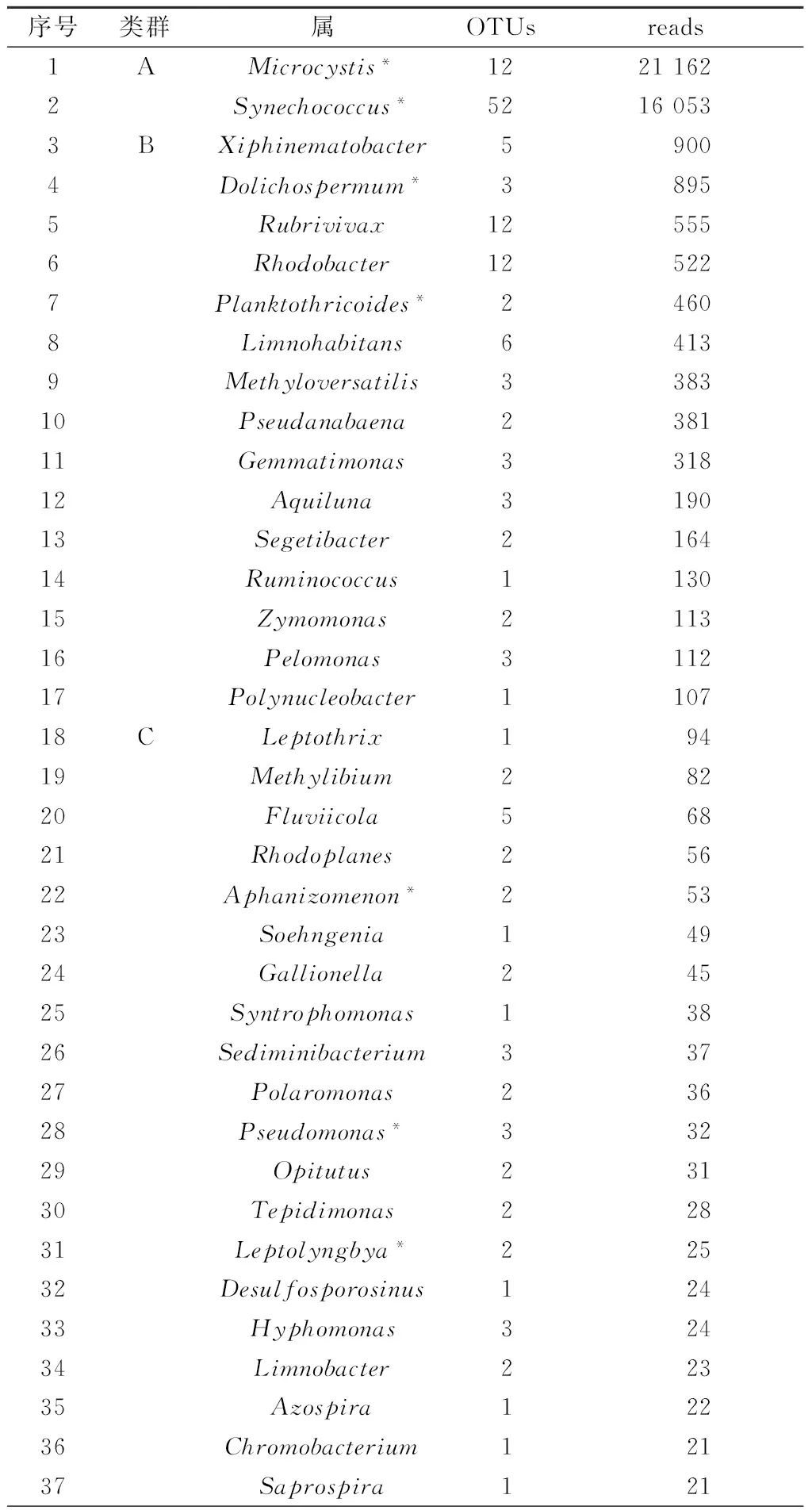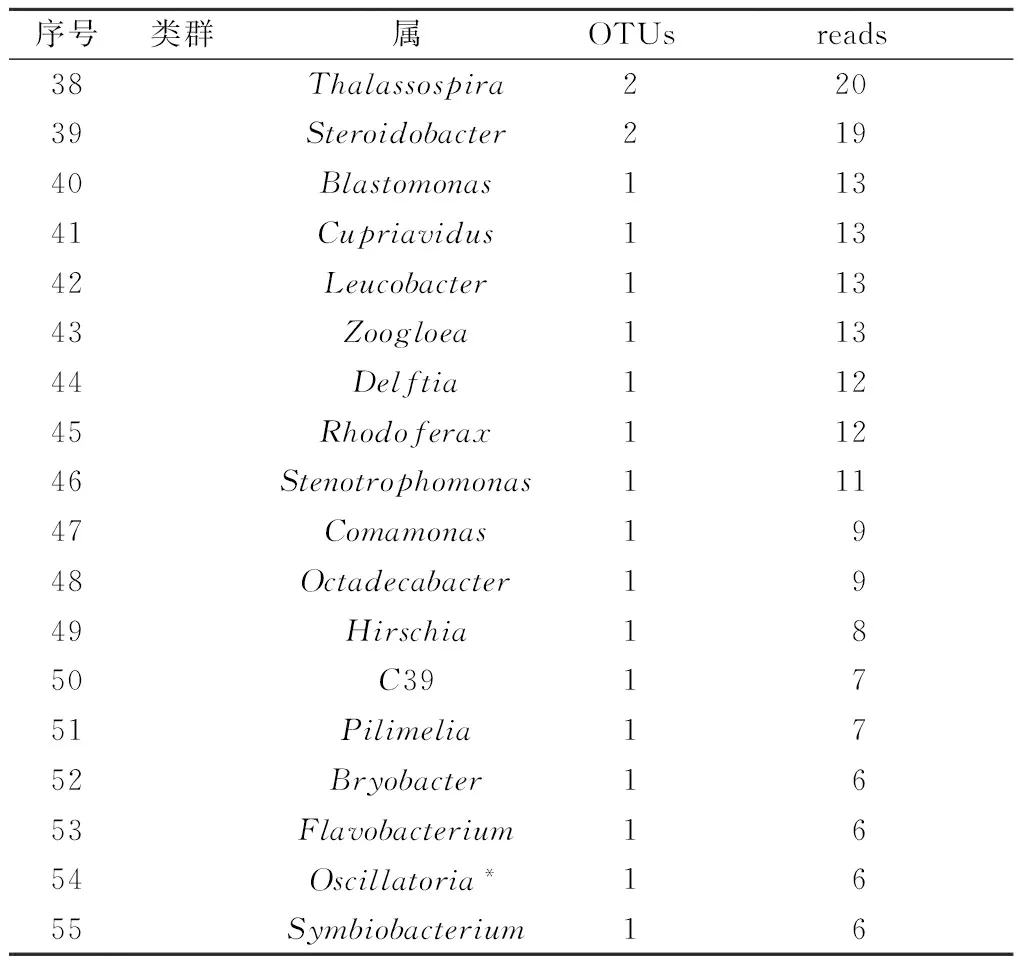夏季太湖梅梁湾水体中细菌的群落结构
2015-04-12徐超张军毅朱冰川宋挺黄君吴蔚
徐超,张军毅,朱冰川,宋挺,黄君,吴蔚
(无锡市环境监测中心站, 江苏 无锡 214121)
夏季太湖梅梁湾水体中细菌的群落结构
徐超,张军毅*,朱冰川,宋挺,黄君,吴蔚
(无锡市环境监测中心站, 江苏 无锡 214121)
利用高通量测序技术,选择16S rRNA V6区作为目标片段,对夏季太湖梅梁湾水体中的细菌群落结构进行了分析,结果表明,共产生了101 427条优质序列,细菌为100 935条,占99.5%;在蓝藻暴发期间,共检测到14门,55属,610个操作分类单位。优势门类为蓝藻门(39.7%),放线菌门(27.2%)和变形菌门(23.4%),微囊藻属(21.0%)和聚球藻属(15.9%)为主要优势种。
高通量测序;群落结构;16S rRNA;太湖
2007年无锡市发生“供水危机”之后,太湖不但成为国际关注的焦点,更是成为大型浅水富营养化湖泊研究的典范[1-12]。近年来,蓝藻水华的持续暴发和最大聚集面积有冬季后移的倾向,表明蓝藻水华监测及其治理的复杂性和艰巨性。
细菌在微食物网的能量流动和物质循环起着关键性作用,在全球性水体富营养化进程中,随着摄食食物链的变细与变短,以及微生物环的持续增粗,细菌在湖泊生态系统中的地位和作用显著增加。目前基于营养盐、气象等研究蓝藻水华暴发的很多[2,13-17],而基于细菌来探索蓝藻水华暴发机制的并不是很多[18-19]。
现利用高通量测序技术,研究蓝藻水华暴发期间的细菌多样性和群落结构,以期为后续研究蓝藻水华和细菌的相互关系、以及探索蓝藻水华的暴发机制提供参考。
1 研究方法
1.1 样本采集及其V6区扩增
样品采自2013年8月23日太湖梅梁湾,取2 L表层水样,用0.22 μm微孔滤膜富集,后立即-20 ℃冷冻。回实验室后即进行DNA提取,采用E.Z.N.A.® Water DNA Kit(OMEGA,USA)。用Nano Drop ND 1000(Thermo Scientific,DE,USA)进行定量分析。V6 目标区的扩增,共27个循环,反应条件如下。预变性:94 ℃,5 min,变性:94 ℃,30 s,退火:50 ℃,30 s,延伸:72 ℃,30 s,最后72 ℃,5 min。为了避免引物扩增的偏向性,采用针对细菌16S rRNA的融合引物。上游引物:967F-PP 5′-CNACGCGAAGAACCTTANC-4′,967F-UC1 5′-CAACGCGAAAAACCTTACC-4′,967F-UC2 5′-CAACGCGCAGAACCTTACC-4′,967F-UC4 5′-ATACGCGARGAACCTTACC-4′,967F-AQ 5′-CTAACCGANGAACCTYACC-4′。下游引物:1046R 5′-CGACAGCCATGCANCACCT-4′,1046R-PP 5′-CGACAACCATGCANCACCT-4′,1046R-AQ1 5′-CGACGGCCATGCANCACCT-4′。
1.2 测序及其数据处理
采用Illumina MIseq PE250测序平台。数据分析可以包含以下流程。首先,初步质量过滤:步长为 1 的5 bp窗口从第一个碱基位置开始移动,窗口中碱基平均质量>Q20,从第一个
2 结果讨论
2.1 测序结果统计
Illumina Miseq PE250测数的数据概要见表1。

表1 测序数据概要①
①有效序列为双端有效拼接后序列;优质序列为去除嵌合体序列;过滤序列为执行0.005%的过滤标准后过滤序列
由表1可见,通过有效拼接、去嵌合体和过滤,可以获得101 427条,平均长度为79的序列(去除了引物)。执行0.005%的过滤标准,去掉<6以下的序列后,共总去掉了18 214条序列,去除滤为15.2%。注解结果中,并未发现古细菌,表明融合引物的特异性较好。仅发现了492条没有比对上的序列,所占比列为0.5%,可见V6区对太湖夏季水体的细菌群落具有较好的识别力。
2.2 细菌群落特征
V6区对于细菌物种的鉴定在门、纲、目、科、属、种等6个分类水平上表现出差异。在门水平上100 935条序列,100.0%可以注解,但到了属水平上,仅有43.5%序列可以注解。物种鉴定的效率是随着分类水平下降呈明显下降趋势,见表2。

表2 各分类水平上的OTUs、个数和序列数
由表2可见,获得了100 935条过滤后的优质细菌序列,隶属于蓝藻门,39.7%;放线菌门,27.3%;变形菌门,23.4%;疣微菌门Verrucomicrobia,2.5%;绿菌门Chlorobi,2.2%;拟杆菌门Bacteroidetes,2.1%;绿弯菌门Chloroflexi,1.1%;浮霉菌Planctomycetes,0.6%;酸杆菌门Acidobacteria,0.5%;芽单胞菌门Gemmatimonadetes,0.4%;厚壁菌门Firmicutes,0.3%;软壁菌门Tenericutes,0.01%;GN02,0.01%;装甲菌门Armatimonadetes,0.01%等14门。其中,优势门类为蓝藻门,放线菌门和变形菌门,合计90.4%。蓝藻门在丰度方面占具明显优势,这主要体现在水体中的微囊藻Microcystis spp.(21.0%)。通过对同步浮游植物样本的显微镜观察分析,微囊藻的优势度高达95.4%。
14门共鉴定了610个OTUs。隶属于变形菌门,42.5%;蓝藻门,16.6%;放线菌门,15.2%;拟杆菌门,9.5%;疣微菌门,4.8%;浮霉菌,3.6%;绿菌门,2.0%;酸杆菌门,2.0%;绿弯菌门,1.1%;芽单胞菌门,1.1%;厚壁菌门,1.1%;软壁菌门,0.2%;GN02,0.2%;装甲菌门,0.2%等14门。其中,优势门类为蓝藻门,放线菌门和变形菌门,合计74.3%。
在属水平上,共鉴定55属,183个分类单元。其中值得关注的是微囊藻属21 162条序列,12个OTUs和聚球藻属16 053条序列,22个OTUs。微囊藻属和聚球藻属序列分别占属水平的21.0%,15.9%, OTUs分别占6.6%,28.4%。
文献[23]通过DGGE的手段对中国富营养化湖泊,太湖和巢湖的细菌群落结构研究表明,在富营养化水平较高的地方,微囊藻占优势种,而在一些藻类生物量较低的地方聚球藻占优势种。除此之外,太湖水体蓝藻门还发现有拟浮丝藻属Planktothricoides、束丝藻属Aphanizomenon、细鞘丝藻属Leptolyngbya、长胞藻属Dolichospermum、颤藻属Oscillatoria和假鱼腥藻属Pseudanabaena等6个常见种类,与光学显微镜观察的结果一致,见表3。

表3 属水平上的种类明细①

续表
①*为蓝藻门;A为高丰度(reads数>10 000) ;B为中丰度(100 太湖蓝藻水华暴发期间,共检测到14门,55属,610个OTUs。细菌群落结构特征较为明显,主要优势门类为蓝藻门(39.7%),放线菌门(27.2%)和变形菌门(23.4%),3门共计90.4%。在属水平上,微囊藻属(21.0%)和聚球藻属(15.9%)为主要优势种。此外,假鱼腥藻在微囊藻胶被中大量存在的现象也被证实。 [1] GUO L.Doing battle with the green monster of Taihu Lake[J].Ecology,2007,317(5842):1166. [2] AKYUZ DE,LUO L,HAMILTON DP.Temporal and spatial tren-ds in water quality of Lake Taihu,China:analysis from a north to mid-lake transect,1991-2011[J].Environmental monitoring and assessment,2014,186(6):3891-3904. [3] BAI X,DING S,FAN C,et al.Organic phosphorus species in surface sediments of a large,shallow,eutrophic lake,Lake Taihu,China[J].Environmental pollution 2009,157(8-9):2507-2513. [4] CAI HY,YAN ZS,WANG AJ,et al.Analysis of the attached microbial community on mucilaginous cyanobacterial aggregates in the eutrophic Lake Taihu reveals the importance of Planctomycetes[J].Microbial ecology,2013,66(1):73-83. [5] CHAO JY,GAO G,TANG XM,et al.Effects of wind-induced wave on organic aggregates physical and chemical characteristics in a shallow eutrophic lake(Lake Taihu) in China[J].Environmental Science,2011,32(10):2861-2867. [6] CHAO JY,GAO G,TANG XM,et al.Effects of ecosystem structure on the organic aggregates physical and chemical parameters of Lake Taihu[J].Environmental Science,2009,30(11):3196-3202. [7] CHEN C,ZHENG B,JIANG X,et al.Spatial distribution and pollution assessment of mercury in sediments of Lake Taihu,China[J].Journal of environmental sciences,2013,25(2):316-325. [8] DENG JC,ZHAI SJ,CHEN Q.Effects of elevated CO2 concentration on the growth of submerged macrophyte Potamogeton malaianus in Taihu Lake[J].The journal of applied ecology,2009,20(6):1299-1304. [9] HE W,SHANG J,LU X,et al.Effects of sludge dredging on the prevention and control of algae-caused black bloom in Taihu Lake,China[J].Journal of environmental sciences,2013,25(3):430-440. [10] LI D,LIU Z,CUI Y,et al.Toxicity of cyanobacterial bloom extracts from Taihu Lake on mouse,Mus musculus[J].Ecotoxicology,2011,20(5):1018-1025. [11] LI D,YU Y,YANG Z,et al.The dynamics of toxic and nontoxic Microcystis during bloom in the large shallow lake,Lake Taihu,China[J].Environmental monitoring and assessment,2014,186(5):3053-3062. [12] ZHU M,ZHU G,ZHAO L,et al.Influence of algal bloom degradation on nutrient release at the sediment-water interface in Lake Taihu,China[J].Environmental science and pollution research international,2013,20(3):1803-1811. [13] HAN XX,ZHU GW,XU H,et al.Source analysis of urea-N in Lake Taihu during summer[J].Environmental Science,2014,35(7):2547-2556. [14] LI JS,ZHANG B,SHEN Q,et al.Analysis of directional reflectance properties of Lake Taihu using multi-angle measurements[J].Spectroscopy and Spectral Analysis,2013,33(9):2506-2511. [15] ZHANG R,QIAN X,ZHU W,et al.Simulation and evaluation of pollution load reduction scenarios for water environmental management:a case study of inflow river of taihu lake,china[J].International journal of environmental research and public health,2014,11(9):9306-9324. [16] ZHANG Y,SHI K,LIU X,et al.Lake topography and wind waves determining seasonal-spatial dynamics of total suspended matter in turbid Lake Taihu,China:assessment using long-term high-resolution MERIS data[J].PloS one,2014,9(5):e98055. [17] ZHOU Q,CHEN W,SHAN K,et al.Influence of sunlight on the proliferation of cyanobacterial blooms and its potential applications in Lake Taihu,China[J].J Environ Sci(China),2014,26(3):626-635. [18] NIU Y,SHEN H,CHEN J,et al.Phytoplankton community succession shaping bacterioplankton community composition in Lake Taihu,China[J].Water research,2011,45(14):4169-4182. [19] SHAO K,GAO G,WANG Y,et al.Vertical diversity of sediment bacterial communities in two different trophic states of the eutrophic Lake Taihu,China[J].J Environ Sci(China) 2013,25(6):1186-1194. [20] JIANG C,BROWN PJ,DUCRET A,et al.Sequential evolution of bacterial morphology by co-option of a developmental regulator[J].Nature,2014,506(7489):489-493. [21] BOKULICH NA,SUBRAMANIAN S,FAITH JJ,et al.Quality-filtering vastly improves diversity estimates from Illumina amplicon sequencing[J].Nature methods,2013,10(1):57-59. [22] FAITH JJ,GURUGE JL,CHARBONNEAU M,et al.The long-term stability of the human gut microbiota[J].Science,2013,341(6141):1237439. [23] CAI Y F,KONG F X,SHI L M,et al.Spatial heterogeneity of cyanobacterial communities and genetic variation of microcystis populations within large,shallow eutrophic lakes(Lake Taihu and Lake Chaohu,China)[J].Journal of environmental sciences,2012,24(10):1832-1842. 投稿须知 为提高编辑部工作效率,缩短稿件审改周期,《环境监控与预警》编辑部在线采编系统现已启用,投稿时,请作者进入《环境监控与预警》编辑部网站(http://www.hjjkyyj.com)。首先注册用户名,填写相关信息后登陆,按页面提示要求进行投稿及查询。本刊已停止E-MAIL投稿方式,特此说明,谢谢合作。 《环境监控与预警》编辑部 Extensive Profiling of a Bacterial Community during Summer in Meiliang Bay,Lake Taihu XU Chao,ZHANG Jun-yi*,ZHU Bing-chuan,SONG Ting,HUANG Jun,WU Wei (WuxiEnvironmentalMonitoringCentralStation,Wuxi,Jiangsu214121,China) In order to explore the prokaryotic community during summer in Meiliang Bay,Lake Taihu, we performed high-throughput sequencing of the 16S rRNA genes V6 hypervariable regions. The results showed that a total of 101 427 quality reads (bacterial reads 100 935, 99.5%) were obtained.Bacteria were found belonging to 14 phyla, 55 genera, and 610 OTUs. At the phylum level, the bacterial community composition was predominated byCyanobacteria(39.7%),Actinobacteria(27.2%),Proteobacteria(23.4%). At the genus level,Microcystis(21.0%) andSynechococcus(15.9 %) was the most abundant genus. High-throughput sequencing; Community structure; 16S rRNA; Lake Taihu 2014-10-11; 2014-12-23 江苏省环境监测科研基金资助项目(1320)。 徐超(1986—),女,助理工程师,硕士,主要从事水域生态学研究。 *通讯作者:张军毅 E-mail:blocksharon@163.com X832 B 1674-6732(2015)01-0037-043 结论
